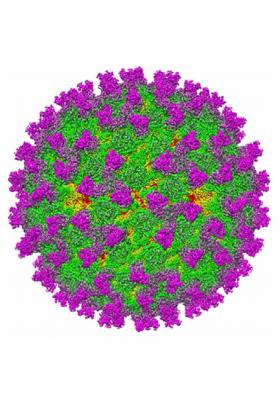



Researchers discovered that Bluetongue virus can hijack the cellular machinery of its host
Researchers at INRA, ANSES, and ENVA have discovered that bluetongue virus can enhance its replication by exploiting one of its host's cellular pathways.Published in the Journal of Virology, their results could help the quest to identify effective antiviral compounds for combating the virus.
Bluetongue virus (BTV) can infect wild and domestic species of ruminants (ovines, caprines, and bovines). It causes a non-contagious disease that is characterised by a broad variety of symptoms: a poor general state of health, fever, localised inflammation, lesions, facial swelling, a bluish cast to the tongue (hence the virus’s name), respiratory problems, mastitis, testicular degeneration, and reproductive issues.
BTV is an arbovirus, which simply means that it is vectored by arthropods. Arboviruses are also responsible for human and animal diseases such as Zika, dengue, chikungunya, West Nile, and Schmallenberg, of which we have seen recent outbreaks. Scientists in the Joint Research Unit for Virology, who are affiliated with INRA, ANSES, and the National Veterinary School of Maisons-Alfort (ENVA), have been studying the molecular interactions between BTV and mammalian host cells. They discovered that the virus can enhance its replication by hijacking one of the host's cellular pathways
 More specifically, this process involves interactions between the viral protein NS3 and the host protein BRAF. Over evolutionary time, BTV has adapted to exploit the key functions mediated by BRAF—cell survival, replication, and differentiation—to enhance its own survival, replication, and propagation. A major virulence factor, NS3 can, through its interactions with BRAF, activate the host's BRAF-dependent pathway and thus increase virus replication.
More specifically, this process involves interactions between the viral protein NS3 and the host protein BRAF. Over evolutionary time, BTV has adapted to exploit the key functions mediated by BRAF—cell survival, replication, and differentiation—to enhance its own survival, replication, and propagation. A major virulence factor, NS3 can, through its interactions with BRAF, activate the host's BRAF-dependent pathway and thus increase virus replication.
The scientists obtained these intriguing results using diverse cellular and biochemical approaches. For example, the research team employed the enzyme inhibitor U0126 to silence the BRAF-dependent pathway. They found that both NS3 levels and BTV replication declined, which underscores that the virus is exploiting this pathway. Overall, these findings could also help explain the high levels of inflammation that can be associated with bluetongue disease.
This work has begun to untangle the molecular interactions between the virus and its host, as well as the underlying mechanisms in operation. The discoveries made can inform future research aiming to predict virulence levels, simulate virus evolution (e.g., virus ability to cross species boundaries), and establish effective measures for controlling arboviruses, notably via the development of broad-spectrum antiviral compounds and new vaccine strains.


